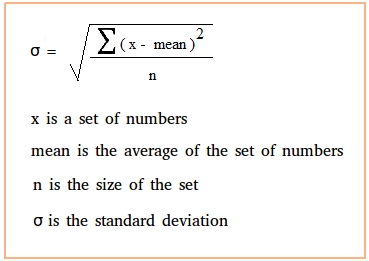Standard Deviation Formula
The standard deviation formula that you will use to find the standard deviation (SD) is shown below.
- x represents a set of numbers. For example, x could be {5, 6, 14, 1, 6, 10}.
- The mean is the average of the set of numbers.
- The symbol Σ refers to an addition.
- n is the size of the list or set. For example, for the set above or {5, 6, 14, 1, 6, 10}, n = 6.
- σ is the symbol or the Greek letter sigma used for standard deviation.

In the formula, the expression inside the square root is called variance. Therefore, the standard deviation is the square root of the variance.
Population standard deviation
If you have collected information or data set from every single member of the population, then you will end calculating the population standard deviation using the formula below.
$$ Population \ standard \ deviation = σ = \sqrt {\frac{Σ(x - µ)^{2}} {N} } $$- x represents all the numbers in the population.
- µ, the Greek letter mu, is the population mean or the average of all numbers in the population.
- The symbol Σ refers to an addition.
- N is the size of the population.
- σ is the symbol used for standard deviation.
Sample standard deviation
If you have collected information or dataset from some members of the population, then you will end calculating the sample standard deviation using the formula below.
$$ Sample \ standard \ deviation = s = \sqrt {\frac{Σ(x - \bar x)^{2}} {n - 1} } $$- x represents all the numbers in the sample.
- x̄ is the sample mean or the average of all numbers in the sample.
- The symbol Σ refers to an addition.
- n - 1 is the size of the sample.
- s is the symbol used for standard deviation.
Notice that the denominator of the variance is n - 1 instead of N in the formula for sample standard deviation. This is an adjustment called Bessel's correction. This division by n - 1 ensures that the sample standard deviation is a good estimate for the population standard deviation. It has been observed by statisticians that when we divide by n, it does not do a good job estimating the population standard deviation. You should use Bessel's correction only if you do not know the population mean and this is usually the case.
Steps to follow when calculating the standard deviation
Step 1: Find the mean of the set of data (mean).
Step 2: Find the difference between each value and the mean (x - mean).
Step 3: Square each difference or each answer you got in step 2 (x - mean)2.
Step 4: Add all the answers you got in step 3 and then divide by the number of answers to get the average. This step will give you the variance.
Step 5: Take the square root of the average found in step 4.
A good example that shows how to use the standard deviation formula to find the standard deviation.
Using the standard deviation formula, I will now show you how to get the standard deviation step by step.
Let S = {4, 6, 8, 2, 5}
Step 1: Find the mean of S = {4, 6, 8, 2, 5}
Step 2: Find the difference between each value in S = {4, 6, 8, 2, 5} and 5
4 - 5 = -1
6 - 5 = 1
8 - 5 = 3
2 - 5 = -3
5 - 5 = 0
Step 3: Square each difference or each answer you got in step 2
-12 = 1
12 = 1
32 = 9
-32 = 9
02 = 0
Step 4: Add 1, 1 9, 9, and 0. Then divide by 5
Step 5: Take the square root of the average found in step 4. That is the standard deviation
Short-cut formula for the standard deviation
Using the short-cut formulas below to find the standard deviation is easier and it will reduce the computation time.
$$ Sample \ standard \ deviation = s = \sqrt {\frac{Σx^2 - \frac{(Σx)^2}{n} } {n - 1} } $$
A good example that shows how to use the shortcut formula standard deviation formula to find the standard deviation.
Using the same dataset S = {4, 6, 8, 2, 5} and the short-cut formula, find SD.
Σx2 = 42 + 62 + 82 + 22 + 52
Σx2 = 16 + 36 + 64 + 4 + 25
Σx2 = 145
Σx = 4 + 6 + 8 + 2 + 5
Σx = 25
(Σx)2 = 252
(Σx)2 = 625
$$ Population \ standard \ deviation = σ = \sqrt {\frac{Σx^2 - \frac{(Σx)^2}{N} } {N} } $$ $$ Population \ standard \ deviation = σ = \sqrt {\frac{145 - \frac{625}{5} } {5} } $$ $$ Population \ standard \ deviation = σ = \sqrt {\frac{145 - 125 } {5} } $$ $$ Population \ standard \ deviation = σ = \sqrt {\frac{20} {5} } $$ $$ Population \ standard \ deviation = σ = \sqrt {4} = 2 $$